Protein complexes that remodel chromatin by making it more or less accessible to DNA-binding proteins play essential roles in the regulation, replication, and expression of the genome — an organism’s complete set of DNA, including all of its genes.
In a recent study, researchers at the University of Sydney have revealed how one such complex, called NuRD and involved in blood cell production, can switch critical genes on and off.
Because one of NuRD’s protein components is known to be involved in breast cancer, the study “CHD4 Is a Peripheral Component of the Nucleosome Remodeling and Deacetylase Complex,” published in The Journal of Biological Chemistry, may lead to the development of new cancer drugs.
Understanding how the NuRD complex works may also explain how certain existing breast cancer drugs act inside the cells.
“This enzyme is like a car and the proteins are the different parts that are used to make it. By knowing how these parts fit together, we can understand how the car works and hence we’re in a better to position to fix it when something goes wrong,” Dr. Daniel Ryan, of Australian National University (ANU) and the John Curtin School of Medical Research, said in a press release.
The NuRD complex, composed of approximately 10 subunits, is a chromatin remodeling complex that plays important roles in gene regulation and DNA repair. The team found that when one of the subunits, called CHD4, is removed from the complex, it remains stable and functional. But the modification in the structure and composition of the complex changes its function from switching gene expression off to switching it on.
“There are treatments for breast cancer which are in use today that are effective but we still don’t know how they work,” Ryan said. “This research shines a light on an important set of proteins that could be targeted by these drugs and superior treatments yet to be developed.”
The research project was developed as part of an international collaboration to understand the mechanisms involved in gene regulation, particularly in cancer and blood disorders.
“Our ongoing research will help to advance our knowledge of how genes are regulated — a phenomenon that is not only vital to normal functions in the body, but also a key factor in many diseases,” Ryan said.

